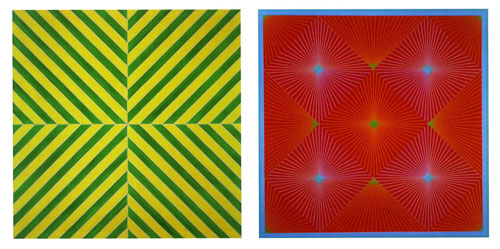Stripes or threads of different colors run over a common background to form diamonds and squares that emerge not as solid forms but as ghostly shapes coming out of nowhere. Some have the misty delicacy of a rainbow; others glow like fluorescent light.
There is about this kind of painting a somewhat mechanical quality, which Anuszkiewicz himself is fully aware of. But the majority of his paintings are so subtle and sensitive that they divulge their secrets only gradually as the viewer looks. And fortunately, the world of color is one of such limitless arrangements and combinations that each painting has, almost automatically, the freshness and excitement of discovery.46
| Frank Stella, Fez, 1964, fluorescent alkyd on canvas. Buffalo (NY), Albright Knox Art Gallery. © 2010 Albright Knox Art Gallery/Art Resource, NY/Scala, Firenze |
 |
Richard Anuszkiewicz, Compleme- ntary Fission, 1964 (cat. no. 1964.4) |
Op Art had arrived. it only needed to be named. Short for "Optical" art and catchily rhyming I with Pop. Op Art was either coined (or ratified) by Brian O'Doherty's feature article in Time magazine (October 23. 1964). "Op Art: Pictures That Attack The Eye". As O'Doherty pointed out. "Op Art has a legitimate ancestry. Cezanne, Seurat and Monet seized upon newly proposed theories of optics when they painted. In this century, constructivists like Mondrian and Malevich were the forebears of Op Art's dry, highly controlled use of color."47 He correctly identified Albers and Victor Vasarely, who worked in Paris, as the immediate "father figures" of Op Art. The artists discussed were mostly Europeans like Vasarely, 56, and Bridget Riley, 32, in England. "Richard Anuszkiewicz, 34, plays with afterimages, or the way one color engenders the false sensation of its complement on the retina. In his Union of the Four, the red pigment throughout the painting is the same hue, despite what the eye sees."48
Meanwhile, the anthology approach of Americans 1963 was consciously rebutted by Clement Greenberg in an exhibition, Post-painterly Abstraction, that opened in Los Angeles in 1964. Greenberg selected 31 different painters whom he designated as the successors to the abstract expressionists. Their shared qualities were a sense of "openness and clarity" and a scrupulously flat picture plane.
